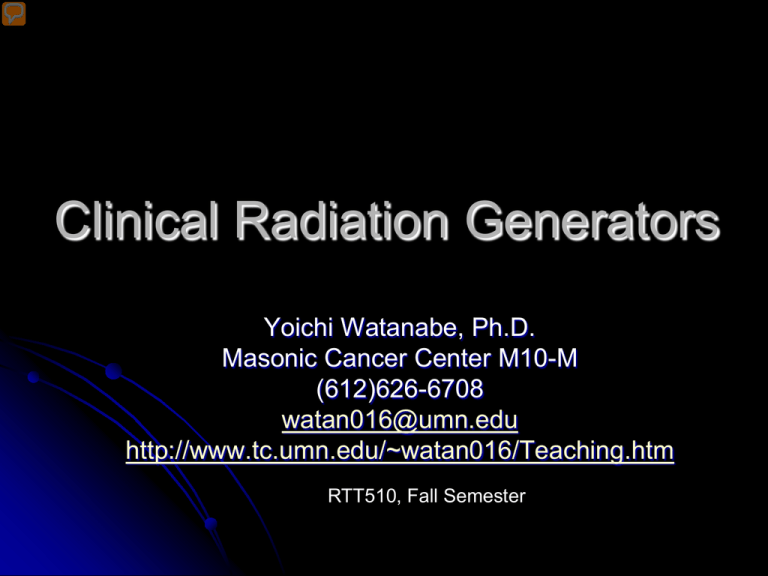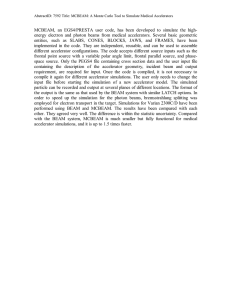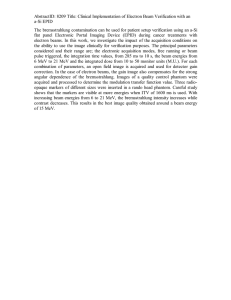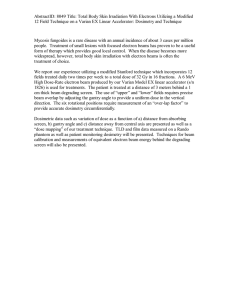Clinical Radiation Generators: Presentation Overview
advertisement

Clinical Radiation Generators Yoichi Watanabe, Ph.D. Masonic Cancer Center M10-M (612)626-6708 watan016@umn.edu http://www.tc.umn.edu/~watan016/Teaching.htm RTT510, Fall Semester Energy unit 1 eV is the energy that an electron or a particle with one electron charge gains in an electric potential of 1 V. 1 eV = 1.602x10-19 J. 1 MeV = 106 eV. Mass can be represented by eV (<= E=mc2). Electron mass = 511.003 keV Proton mass = 938.280 MeV Neutron mass = 939.573 MeV π0-meson (pion) mass = 134.96 MeV 1 amu = 931.502 MeV Absorbed Dose Unit of dose is Gy (Gray). 1 Gy = 1 J /kg. 1 calorie (cal.) / 1 g of water raises the water temperature by 1 degree. 1 cal = 4.18 J. 1 cGy = 0.01 Gy. 1 Gy = 1/4.18 cal/kg = 0.24 x10-3 cal/g. => 0.00024 degree. To kill cells, one needs 10 Gy (=1,000 cGy). Depth dose of kVp X-rays a) Grenz rays, HVL=0.04mm Al, φ=33cm, SSD=10cm b) Contact therapy, HLV=1.5mm Al, φ=2cm, SSD=2cm c) Superficial therapy, HVL=3mm Al, φ=3.6cm, SSD=20cm d) Orthovoltage, HVL=2mm Cu, 10x10cm2, SSD=50cm e) Co-60 γ-rays, 10x10cm2, SSD=80cm Requirements of clinical radiation generators 1. 2. 3. 4. 5. 6. 7. 8. High particle energy for penetration High particle flux for sufficient dose rate Energy efficient Compact Not too expensive Reliable Simple to operate Safe Brief History 1895 1913 1931 1932 1939 1946 1952 1956 1958 1959 1976 1990 K.Roentogen discovers X-rays. W.E.Coolidge develops vacuum X-ray tube. E.O.Lawrence develops a cyclotron. 1MV Van de Graaff accelerator installed, Boston (USA). First medical cyclotron, Crocker (USA). 20MeV electron beam therapy with a Betatron, Urbana (USA). First Co-60 teletherapy units , Saskatoon (Canada). First 6MeV linear accelerator, Stanford (USA). First proton beam therapy (Sweden). First scanning electron beam therapy, Chicago (USA). First pion beam therapy, LAMPF (USA). First hospital based proton therapy, Loma Linda (USA). Bremsstrahlung Process Force F=k ze ⋅ Ze r r 2 F = ma Acceleration Ze ⋅ ze a∝ m X-ray intensity Z 2 z 2e6 2 I rad ∝ (a ⋅ e ) = m2 Principle of x-ray emission Bremsstrahlung The process of bremsstrahlung (braking radiation) is the result of radiative collision between a high speed electron and a nucleus. The probability of bremsstrahlung production varies with Z2, where Z is the atomic number of the target. The efficiency (the ratio of output energy emitted and to the input electron energy) is proportional to Z and E (the energy of the electron). Bremsstrahlung Process Photon Angular Distribution Bremsstrahlung (2) X-rays are emitted more or less equally in all directions at electron energy below about 100 keV. As electron energy increases, the direction of x-ray emission becomes increasingly forward => transmission-type target. Principle of electron acceleration Electrons (or charged particle) can be accelerated in electric field. F = qE q F V E Basic components Power supply Strong electric field generator Vacuum tube Particle (or electron) generator/source Target, to produce particles for therapy Beam collimator Beam modulator Beam controller Acceleration Methods High voltage linear method 1. Transformer => alternate current (AC). Van de Graaff electrostatic generator. 3. Linear RF method Betatron <= magnetic induction 4. Circular RF method 2. Microtron Cyclotron (=> Synchrotron) Types of radiation generators kVp therapy machines Van de Graaff accelerator Betatron Microtron Linear accelerator Cyclotron Radioactive source based therapy units Kilovoltage Therapy Units Photons are generated by hitting a solid target with electrons via Bremsstrahlung interactions. The electron energy is below 300 keV or the acceleration potential is smaller than 300 kV. The photon energy spectrum is broad. Type of kV therapy Grenz-ray therapy: < 20 kV Contact therapy: 40 kV ~ 50 kV Superficial therapy: 50 kV ~ 150 kV Orthovoltage (or deep) therapy: 150 kV ~ 500 kV Supervoltage therapy: 500 kV ~ 1000 kV Megavoltage therapy: 1 MV Contact Therapy Accelerating potential = 40 to 50 kV. Tube current = 2 mA SSD = 2 cm Beam hardening by 0.5- to 1.0-mm aluminum filter. Useful for tumors not deeper than 1 to 2 mm. Superficial therapy Accelerating potential = 50 to 150 kV. 1- to 6-mm aluminum for beam hardening. Half-value layer (HVL) = 1- to 8-mm Al. Applicators or cones for field collimation. SSD = 15 to 20 cm. Useful for tumors confined to about 5-mm depth. Orthovoltage therapy Potential = 150 to 500 kV. Beam current = 10 to 20 mA. HVL = 1 to 4 mm Copper (Cu). SSD = 50 cm. Philips RT250 Depth dose of kVp X-ray 100 kVp 300 kVp Supervoltage therapy Potential = 500 to 1000 kV. Resonant transformer is used. Types of radiation generators kVp therapy machines Van de Graff accelerator Betatron Microtron Linear accelerator Cyclotron Radioactive source based therapy units Van de Graaff generator An electrostatic accelerator Can reach 35 MV. Can produce beam current of about 1 mA. Voltage is limited by insulation. Not used for therapy now. http://www.answers.com/topic/van-de-graaff-generator Types of radiation generators kVp therapy machines Van de Graff accelerator Betatron Microtron Linear accelerator Cyclotron Radioactive source based therapy units Betatron principle Faraday’s law of induction Betatron in 1940 Siemens Betatron in 1952 15 MeV electron beam Betatron Betatron was the first electron accelerator used for radiotherapy in early 1950s. An electron in a changing magnetic field experiences accelerator in a circular orbit. Can produce 6 MeV to 40 MeV electrons. Electron beam current is low for photon therapy. Types of radiation generators kVp therapy machines Van de Graff accelerator Betatron Microtron Linear accelerator Cyclotron Radioactive source based therapy units Microtron Principle Electrons are accelerated by the electric field every time the electrons pass through the resonator. Microtron Microtron is used to accelerate electrons. Electron energy spread is small. Easy to select energy. Simple. Types of radiation generators kVp therapy machines Van de Graff accelerator Betatron Microtron Linear accelerator Cyclotron Radioactive source based therapy units Modern Linear Accelerators Siemens Primus Varian Triology Elekta Synergy New Generation Tomotherapy HiART Accuray Cyberknife Components of Linac Power supply Electron source or gun RF (radio-frequency) wave generator Accelerator tube Treatment head (or gantry) Bending magnets Target Filters: flattening and electron foil Primary collimator Secondary collimators or primary jaws Beam monitor ionization chamber Linear accelerator (linac) Karzmark and Pering, 1973 Siemens Accelerator Varian HDX Modulator A power supply provides DC power to the modulator. The modulator includes the pulse-forming network (PFN) and hydrogen thyratron (a switch tube). The modulator generates high-voltage pulses, which are flat-topped DC pulses of a few microseconds in duration. Structure of electron guns Diode Triode with control grid Microwave Oven Scientific American, Oct 2008 Magnetron Generates microwave pulses (3 GHz, one pulse every 2 ms). Provide microwaves to accelerating structures. Used with low-energy linacs (6MV or lower). Klystron Microwave amplifier. (x100,000) Needs a low-power microwave oscillator. Basic ideas of linear accelerator Charged particles (or electrons) are accelerated by the electric field of radiofrequency (RF) waves. Electrons 50 keV E 5 – 20 MeV/m ~ 400 mA for photon beam Principle of Acceleration Person on a surfboard riding an ocean wave and a fish below the waves. Temporal structure of electron beam 3 ms Time 3 GHz Accelerator structure: Traveling-wave type Microwave power is fed to the structure. Waves travel through the accelerating structure. The residual power is absorbed at the distal end of the structure. Electrons injected at one end of the structure from an electron gun travel to the other end of the structure. Traveling-wave Karzmark and Pering, 1973 Traveling-wave guide Accelerator structure Standing-wave type Microwave power can be fed anywhere along the length of the structure. Combination of forward and reverse traveling waves gives rise to standing waves. The half of cavities have essentially zero EM field; hence, those are moved off-axis. So there are accelerating cavity and coupling cavity (or bimodal design). Standing-wave Karzmark and Pering, 1973 Standing-wave guide Karzmark and Pering (1973) TW vs. SW The efficiency of conversion of RF power to electron energy is about twice as high as in SW as in TW. For the same beam energy, SW guide is much shorter than TW guide. SW is many times more stable than TW. TW is less cost than SW. Accelerator head Photon beam For electron beam No target Scattering foil Electron cone Kim et al, Med Phys 28,2457 (2001) Monte Carlo Model of Linac Head Monitor Ionization Chamber Counts the number of ion pairs produced in a sealed air cavity by photons or electrons. (The number of ion pairs is proportional to the particle flux.) Serves as beam-on-timer. Beam turns off when a pre-set number of ion pairs (or monitor unit) produced in the chamber. There are two monitor chambers for safety. Consists of four sectors to monitor symmetry and flatness of the beam. Multileaf Collimator Depth dose characteristics of electron and photon beams Auxiliary Systems Vacuum system generates vacuum in klystron, electron gun, accelerator guide, and the beam transport section. Water cooling system is used to cool the accelerator structures, RF power source, and electromagnet systems in the gantry. Dielectric gas, SF6 (w/ Klystron) or Freon (w/ Magnetron), fills wave guides to prevent electric discharge or arcing. Types of radiation generators kVp therapy machines Van de Graff accelerator Betatron Microtron Linear accelerator Cyclotron Radioactive source based therapy units Lorentz Force 𝐹𝐹⃗ = 𝑞𝑞𝐸𝐸 + 𝑞𝑞𝑣𝑣⃗ × 𝐵𝐵 Cyclotron Charged particles are accelerated by electric field cyclically. Charged particles fly in circular orbits in magnetic field. The radius of the orbits increases as the particle speed increases. Synchrotron was invented to overcome the energy limit. Diagram of Cyclotron Dee High voltage High frequency oscillator Target http://www.physics.rutgers.edu/cyclotron/theory_of_oper.shtml Medical applications of cyclotron Used to generate high energy protons and heavy ions for therapy. Used to accelerate deuterons to produce neutrons. Used for the production of radionuclides. i.e. for PET. Synchrotron Synchrotron (2) Heavy particle therapy Particles heavier than electrons have radiobiological advantages, or higher LET. Depth dose of heavy charged particle shows Bragg peak. Neutrons Protons Heavy ions: 12C Pions Neutron generators D-T generator -> 14 MeV neutrons 2 1 H + H → He + n 3 1 4 2 100 to 300 keV Cyclotron -> 40 MeV neutrons 2 1H (or 15 to 50 MeV 9 10 p )+ 4 Be→ 5 B +n Depth dose characteristics of electron and photon beams Depth dose of charged particles Bragg peak Spread Out Bragg Peak (SOBP) π Siemens Medical Solutions, Inc. − A.R.Smith, Med Phys (1977) Range of heavy charged particles The range of heavy charged particles is proportional to the mass and inverse proportional to the square of the electric charge for the same particle energy (i.e. energy per nucleon). The range of 160 MeV proton is 18 cm. For the same initial velocity, 2 R1 M 1 Z 2 = R2 M 2 Z1 Particles with the same kinetic energy per nucleon (MeV/u) have the same velocity. 150 MeV protons, 300 MeV deuterons, and 600 MeV helium ions all have the velocity. Negative pion therapy The mass of pion is 273 times of electron. Negative pions are generated by colliding protons (400 to 800 MeV) with a beryllium target. Star formation takes place near the end of pion passage via pion capture. Hence, the Bragg peak is more pronounced. Pion therapy is not currently pursued for clinical uses because of low dose rates, beam contamination, and high cost. Proton accelerator 150 MeV to 250 MeV Heavy ion therapy facility Heavy Ion Medical Accelerator in Chiba (HIMAC) Linac Synchrotron Types of radiation generators kVp therapy machines Van de Graff accelerator Betatron Microtron Linear accelerator Cyclotron Radioactive source based therapy units Machines using radionuclides Gamma rays from Cs-137, Co-60, Ra-226. Co-60 units are commonly used for therapy. Radionuclides Half-life [years] γ energy [MeV] Γ value [Rm2/Ci hr] [Ci/g] Ra-226 0.5mm Pt 1622 0.83 0.825 0.98 Cs-137 30.0 0.66 0.326 50 Co-60 5.26 1.17, 1.33 1.30 200 Co-60 unit 60 Co is generated from 59Co via 59Co(n,γ) 60Co reactions. The half-life for 60Co is 5.26 years. 60 Co decays to 60Ni with the emission of β particles and two photons (1,17 MeV and 1.33 MeV) per disintegration. The Co source is a cylindrical capsule of 1 cm diameter and 1 cm long, causing relative large penumbra. β particles are absorbed in the Co-metal and the stainless steel capsule. Theratron Sourcehead Dose the source size matter? W =D SSD − SDD SDD Source diameter, D (= 1 to 2 cm) SDD Jaw SSD Penumbra width, W CAX Gamma Knife Gamma Knife side view





